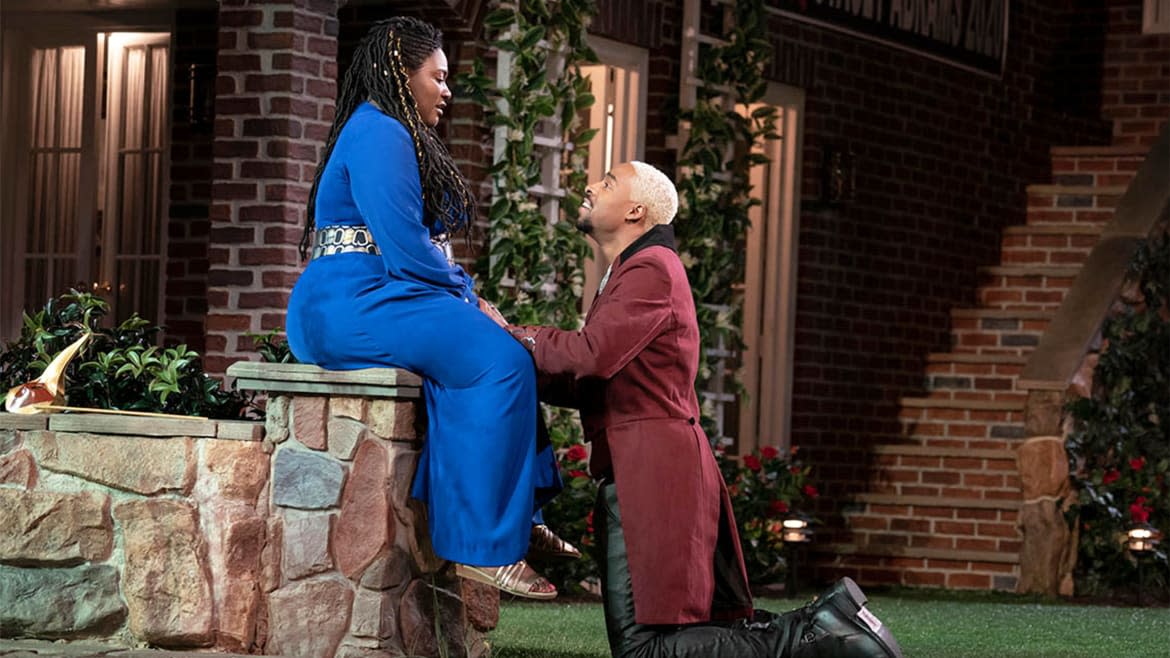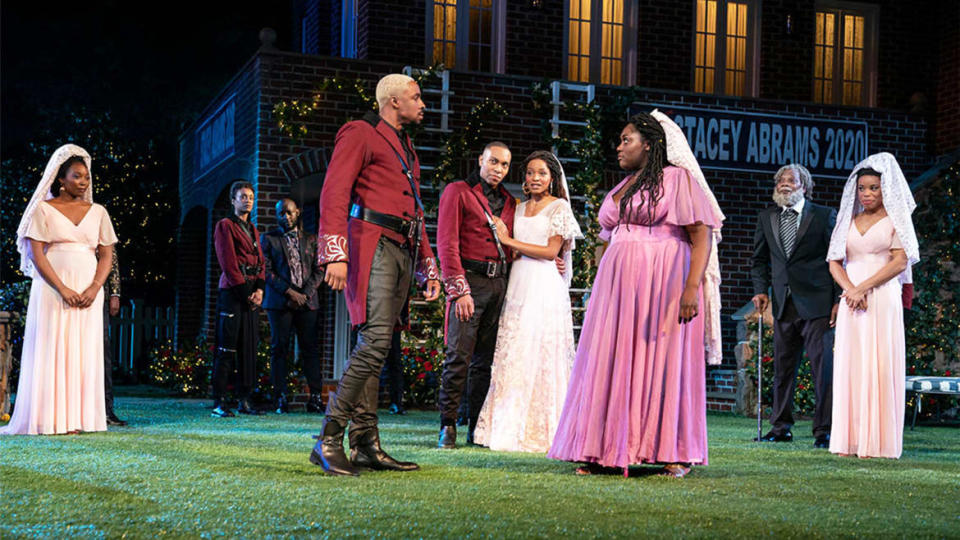‘Much Ado About Nothing’: A Shakespeare Classic Celebrates Its Black Power in Central Park

The Aragon, Spain, of Shakespeare has been swapped for Aragon, Georgia, in the run-up to the 2020 election in Kenny Leon’s contemporary adaptation of Much Ado About Nothing (to June 23), showing as part of the Public Theater’s annual Delacorte Theater jewel, Shakespeare in the Park.
There is nothing as obviously Trump-focused as the Julius Caesar that became the center of frothingly absurd right-wing controversy here in 2017.
Democracy—Not Donald Trump—Dies Brutally in ‘Julius Caesar,’ Just as Shakespeare Intended
Instead, on stage in front of us is an impressively sturdy-looking red-brick house (designed by Beowulf Boritt), emblazoned with a banner, “Stacey Abrams 2020,” which makes the play’s location, political affiliations, and desires for a dream entrant to the 2020 election pretty clear.
Characters dart into its doors, appear on its balconies, and hide and play in its patio and on its grassy garden. The gorgeous stage is used in its fullest; a car even draws up at the beginning. Hip-hop, R&B, and (for the play’s two set songs) a guitar are musical accompaniments. The soldiers returning from Shakespeare’s unnamed war here carry signs saying “Hate Is Not a Family Value” and other anti-racist, anti-extremist slogans.
The war that brackets this play, happening somewhere not far away, is a cultural one we only too easily recognize, and one that—Leon suggests—requires the active engagement of those who wish to fight for the rights of minorities in the Trump era, where the forces of the far right have felt emboldened to attack women, people of color, LGBT communities, and immigrants.
The cast is all-black, speaking Shakespeare’s language and equipped with a battery of cultural signifiers for now. The costumes puzzlingly meld historic and modern; at the beginning you wonder if a modern meta-audience is watching modern actors playing period (they are not). The teases of the modern world could do with being more pronounced, or just jettisoned.
No words have been added by Leon to the play, but Danielle Brooks’ Beatrice is absolutely of today. Brooks—multi-award winning as Taystee in Orange Is the New Black, and Tony-nominated and Grammy-winning for The Color Purple on Broadway—is wonderful; a fiery, no-prisoners-taken vocalizer of feminism and equality who will do all she can to resist the charms of Benedick (Grantham Coleman). Their courtship is meddled with by friends meaning well. Latefah Holder’s constable, Dogberry, leads her band of all-over-the-place Keystone Cops-like watchmen.
The play spends an equal amount of time on the romantic travails of Claudio (Jeremie Harris) and Hero (Margaret Odette). This—not for the first time in a Much Ado production—feels like so much less than the Beatrice and Benedick plot, even though Don John’s (Hubert Point-Du Jour) scheming against Claudio and Hero is so much more grave. This, as Leon and company emphasize, is a play partly predicated on men sullying women’s reputations, and the male desire to dominate.

The play is eternally, bizarrely split between the lightness and games of Beatrice and Benedick, and the high-stakes drama of Claudio and Hero, and Leon’s production doesn’t clarify this odd tonal juxtaposition. Beatrice and Benedick, especially as played by Brooks and Coleman, you care about. Everything else happening around them feels like filler.
The delight is in both individual performances and the excellent, energy-packed company. In the moments where she must conceal herself, Brooks’ Beatrice heads toward us to shelter and conceal herself on audience members’ laps. Benedick hides in the patio and dances as surreptitiously as he can.
The play doesn’t really move on from its basic plot complications, but Leon and his cast sharpen its gender politics, with Brooks especially winning in her witty and resolute one-woman battle against sexism.
Camille A. Brown’s choreography brings extra life to the text. The collective sense of play and joy of a diverse group of bodies is as notable in Leon’s vibrant production as Shakespeare’s words. And then there is the Delacorte itself, which on a warm, rain-free evening is simply a beautiful place to watch theater in an audience that is, as artistic director Oskar Eustis intends, truly diverse.
This distinctive open-air pleasure is not so seductive that it obscures the play’s structural oddities and some of the puzzles of this adaptation, but this company powerfully attempts to customize a Shakespeare for today, and the setting in the darkening park, trees looming all around, will always add to the charm and thrill of an ambitious adaptation such as Leon’s.
At the end of this Much Ado, we see that the culture war continues—somewhere out there, somewhere very much among us. This production of Much Ado, set squarely in the Trump era, begins and ends with both warning and rallying call.
Get our top stories in your inbox every day. Sign up now!
Daily Beast Membership: Beast Inside goes deeper on the stories that matter to you. Learn more.

